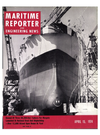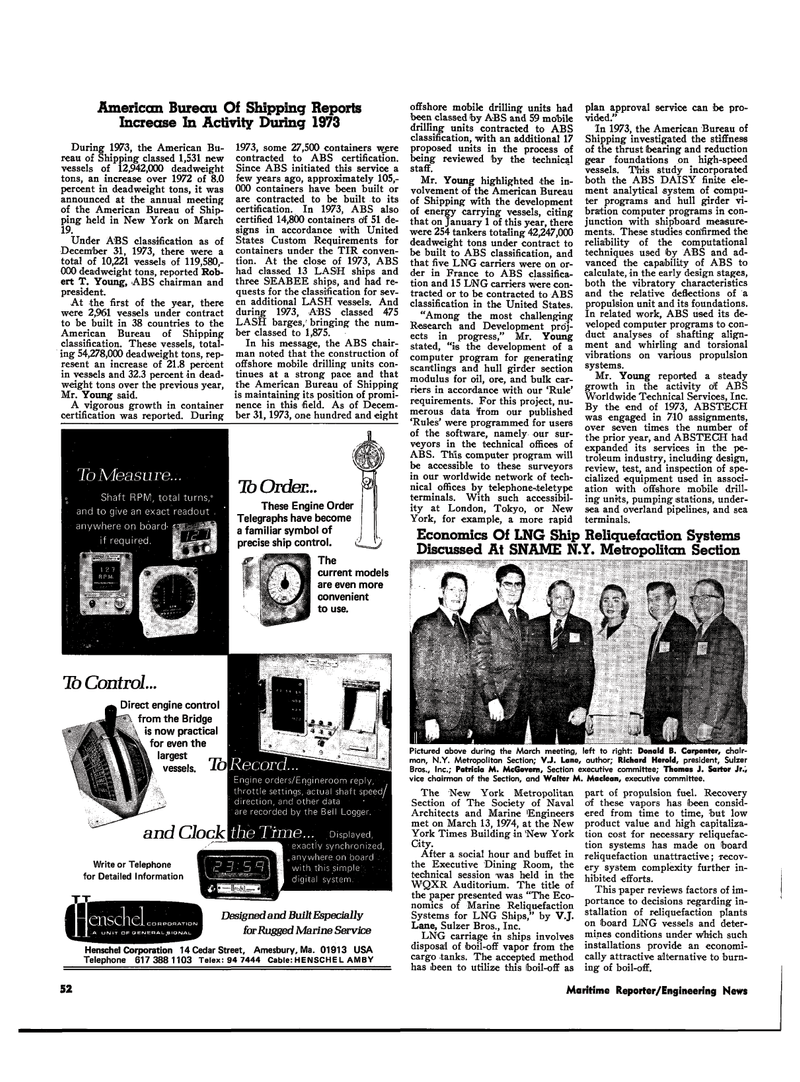
Page 51: of Maritime Reporter Magazine (April 15, 1974)
Read this page in Pdf, Flash or Html5 edition of April 15, 1974 Maritime Reporter Magazine
American Bureau Of Shipping Reports
Increase In Activity During 1973
During 1973, the American Bu- reau of Shipping classed 1,531 new vessels of 12,942,000 deadweight tons, an increase over 1972 of 8.0 percent in deadweight tons, it was announced at the annual meeting of the American Bureau of Ship- ping held in New York on March 19.
Under A'BS classification as of
December 31, 1973, there were a total of 10,221 vessels of 119,580,- 000 deadweight tons, reported Rob- ert T. Young, ABS chairman and president.
At the first of the year, there were 2,961 vessels under contract to be built in 38 countries to the
American Bureau of Shipping classification. These vessels, total- ing 54,278,000 deadweight tons, rep- resent an increase of 21.8 percent in vessels and 32.3 percent in dead- weight tons over the previous year,
Mr. Young said.
A vigorous growth in container certification was reported. During 1973, some 27,500 containers were contracted to ABS certification.
Since ABS initiated this service a few years ago, approximately 105,- 000 containers have been built or are contracted to be built to its certification. In 1973, ABS also certified 14,800 containers of 51 de- signs in accordance with United
States Custom Requirements for containers under the TIR conven- tion. At the close of 1973, ABS had classed 13 LASH ships and three SEABEE ships, and had re- quests for the classification for sev- en additional LASH vessels. And during 1973, ABS classed 475
LASH barges, bringing the num- ber classed to 1,875.
In his message, the ABS chair- man noted that the construction of offshore mobile drilling units con- tinues at a strong pace and that the American Bureau of Shipping is maintaining its position of promi- nence in this field. As of Decem- ber 31, 1973, one hundred and eight
To Measure...
Shaft RPM, total turns," and to give an exact readout anywhere ori board- • i j
To Order...
These Engine Order
Telegraphs have become a familiar symbol of precise ship control.
The current models are even more convenient to use.
H""" "
To Control...
Direct engine control from the Bridge s now practical for even the largest vessels. J-O and Clock
Write or Telephone for Detailed Information
Record
Engine orders/Engineroom reply, throttle settings, actual shaft speed/ direction, and other data are recorded by the Bell Logger. the Time... Displayed, exactly synchronized, 0anywhere on board with this simple . digital system. n sclieL
NIT OF OENERAL,8IONAL
Designed and Built Especially for Rugged Marine Service offshore mobile drilling units had been classed by ABS and 59 mobile drilling units contracted to ABS classification, with an additional 17 proposed units in the process of being reviewed by the technical staff.
Mr. Young highlighted the in- volvement of the American Bureau of Shipping with the development of energy carrying vessels, citing that on January 1 of this year, there were 254 tankers totaling 42,247,000 deadweight tons under contract to be built to ABS classification, and that five LNG carriers were on or- der in France to ABS classifica- tion and 15 LNG carriers were con- tracted or to be contracted to ABS classification in the United States. "Among the most challenging
Research and Development proj- ects in progress," Mr. Young stated, "is the development of a computer program for generating scantlings and hull girder section modulus for oil, ore, and bulk car- riers in accordance with our 'Rule' requirements. For this project, nu- merous data 'from our published 'Rules' were programmed for users of the software, namely our sur- veyors in the technical offices of
ABS. This computer program will be accessible to these surveyors in our worldwide network of tech- nical offices by telephone-teletype terminals. With such accessibil- ity at London, Tokyo, or New
York, for example, a more rapid plan approval service can be pro- vided."
In 1973, the American Bureau of
Shipping investigated the stiffness of the thrust bearing and reduction gear foundations on high-speed vessels. This study incorporated both the ABS DAISY finite ele- ment analytical .system of compu- ter programs and hull girder vi- bration computer programs in con- junction with shipboard measure- ments. These studies confirmed the reliability of the computational techniques used by ABS and ad- vanced the capability of ABS to calculate, in the early design stages, both the vibratory characteristics and the relative deflections of a propulsion unit and its fpundations.
In related work, ABS used its de- veloped computer programs to con- duct analyses of shafting align- ment and whirling and torsional vibrations on various propulsion systems.
Mr. Young reported a steady growth in the activity of ABS
Worldwide Technical Services, Inc.
By the end of 1973, ABSTECH was engaged in 710 assignments, over seven times the number of the prior year, and ABSTECH had expanded its services in the pe- troleum industry, including design, review, test, and inspection of spe- cialized equipment used in associ- ation with offshore mobile drill- ing units, pumping istations, under- sea and overland pipelines, and sea terminals.
Economics Of LNG Ship Reliquefaction Systems
Discussed At SNAME N.Y. Metropolitan Section
Pictured above during the March meeting, left to right: Donald B. Carpenter, chair- man, N.Y. Metropolitan Section; V.J. Lane, author; Richard Herold, president, Sulzer
Bros., Inc.; Patrieia M. McGovem, Section executive committee; Thomas J. Sartor Jr.", vice chairman of the Section, and Walter M. Maclean, executive committee.
Henschel Corporation 14 Cedar Street, Amesbury, Ma. 01913 USA
Telephone 617 388 1103 Telex: 94 7444 Cable: HENSCHE L AMBY
The New York Metropolitan
Section of The Society of Naval
Architects and Marine 'Engineers met on March 13, 1974, at the New
York Times Building in 'New York
City.
After a social hour and buffet in the Executive Dining Room, the technical session was held in the
WQXR Auditorium. The title of the paper presented was "The Eco- nomics of Marine Reliquefaction
Systems for LNG Ships," by V.J.
Lane, Sulzer Bros., Inc.
LNG carriage in ships involves disposal of boil-off vapor from the cargo tanks. The accepted method has been to utilize this boil-off as part of propulsion fuel. Recovery of these vapors has been consid- ered from time to time, but low product value and high capitaliza- tion cost for necessary reliquefac- tion systems has made on board reliquefaction unattractive; recov- ery system complexity further in- hibited efforts.
This paper reviews factors of im- portance to decisions regarding in- stallation of reliquefaction plants on board DNG vessels and deter- mines conditions under which such installations provide an economi- cally attractive alternative to burn- ing of boil-off. 52 Maritime Reporter/Engineering News

 50
50

 52
52
